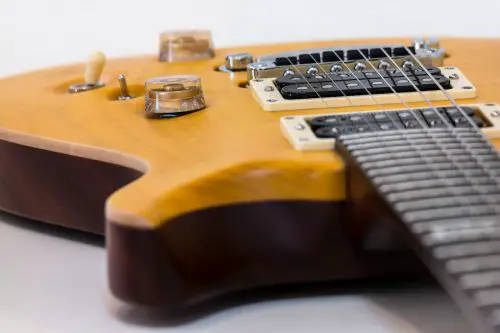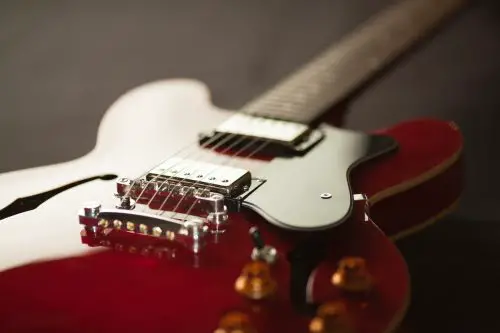Hot pickups are ones with a signal output that is more powerful or has a higher resistance than a typical one. When someone says one pickup is “hotter” than another, they are essentially comparing the output power of the two pickups.
They are typically louder than low output since they provide more signal and are therefore more likely to drive the amplifier, but they might not always produce as clear and bright of a sound.
A high-output and low-output pickup can be distinguished from one another quite easily. Pickups with higher output have more windings than pickups with lower output.
They are more resistant as a result, and the signal is hotter or louder. In addition, ceramic magnets are frequently used in high-output pickups rather than alnico ones.
In this article, I will be letting you in on certain things you should know about hot or hotter pickups if they are better compared to low output and how you can check your guitar’s pickup resistance.
Are Hotter Pickups Louder?

Yes, Hotter pickups are more louder because this will make your guitar output a stronger signal
Hotter pickups are louder because they cause your guitar to create a stronger signal, which then forces your amplifier’s first gain stage to work harder and produce a louder sound.
A hot output is very loud or produces a lot more output than other signals (as well as pickups, which can include bass drum microphones among others).
Also Read: Does Guitar Pickup Matter? Sound Difference On Type & Price
Are Hot Pickups Better? (Compared To Low Output)
Hotter pickups are louder but they are not necessarily better compared to low output. The pure, natural sound that the low output produces is generally preferred by guitarists.
Hot pickups can mask articulation and blur notes. By pushing your amp harder, they offer you heavier overdrive tones, and this might sound more compressed with a tighter feel.
Some players believe it’s a mistake to get extremely hot pickups simply to be able to push a powerful amplifier into distortion.
They find that hot pickups sound dark and characterless, dominating the guitar’s natural character, and don’t provide a wide variety of clean tones.
However, pickups with reduced output or resistance enable better note articulation. They tend to generate a more bluesy or vintage-sounding distortion and drive the front end of your amp less.
With firm lows, sweeter highs, and a less aggressive midrange that is nevertheless snappy and tight, lower-gain pickups better express the subtleties of your approach, style, and dynamics. Their tone strikes as being open.
They are better at conveying the full range of your playing style since they are more touch sensitive. Additionally, they don’t overtax your amplifier’s preamp stage or effects as much as hot pickups do.
Nevertheless, deciding to employ a high pick-up relies on the type of music being played. Heavy music is better suited for hot pickups.
They rely on a powerful signal entering the amplifier, which is further distorted by the preamp tubes (or the emulated preamp tubes), and then being forced into the power amp.
High output pickups, such as the Invader, are intended to deliver a steady output, although a very high one. This is ideal for heavier music, which distinguishes itself by its use of volume for solos, tightness in the bass end, and speed.
Additionally, a player could decide to use a low output solely for dynamics’ sake. Higher output pickups with their powerful magnets have an impact on the vibrations of the string, but lower output pickups do not. So, in a way, you may enhance sustain if the string can vibrate more freely.
You can play complicated chords with some overdrive and still hear the distinct voices if your pickups have a lower output.
Therefore, use higher output pickups for heavy genres while exploring the low and medium output pickups for anything with a lower gain than that.
Also Read: Do Old Pickups Sound Better? (Impact Of Age & Wear)
How Many Ohms Is a Hot Pickup?

There is not a standard range but most pickups are going to fall somewhere in between 6k to 20k ohms
Although there is no set range, the majority of pickups will fall between 6k and 20k ohms – pickups around 16k-20k ohms are considered hot pickups. There are the single-coil pickups and humbucker pickups.
The humbuckers pickups are designed to be typically much “hotter” than single coils. Because a humbucker uses two single coils in series, it may have twice as many coils as the pickup itself.
This effect is why single coils don’t drive your amp to distortion as soon as a humbucker will and thus they normally sound clean.
They usually measure at around 8k ohms for a vintage-style pickup to as much as 25k ohms for a high-output pickup.
On the other hand, single coils were the first electric guitar pickups made. They are long, slender oval shapes covered in plastic that have magnetic circles inside of them.
Although technically you could attach them anywhere the strings meet depending on the sound you’re after. They are often mounted about the center of the body.
The output of single coil pickups can vary from anywhere in the 6-8k range in “vintage voiced” up to 16k (high-output).
How Do You Increase Pickup Output on a Guitar?

You can easily increase your pickup output by doing some simple adjustments
You can increase your pickup output by performing some adjustments. You can alter the height of the pole pieces, the number of windings per coil, install modifications, and the height of the overall pickup to the strings, among other things, according to your particular requirements.
The most common method is to raise the pickups’ height to bring them closer to the strings to increase volume. Be careful not to raise the pickups too much, though, as doing so may lower the quality of your sound.
Not usually the ideal solution, and it’s bad if the strings can’t be fretted on some of the higher notes without touching the pickups. There is a component here that will raise your output and is built into the input jack; however, it is more expensive than buying a new pickup.
Another option is to purchase a Bad Monkey at your neighborhood GC, which will unquestionably improve your signal. Also, a potentiometer’s value can be increased without increasing the volume.
You may need to adjust the capacitor value on the potentiometer used to set the frequency range of the input signal from the instrument, which may assist a little. The boost seems like your best choice, in my opinion.
So, if you want to heat and grunge from a lower output pickup, simply turn it up; you can still achieve this sound using the volume or gain knobs on your amp, a good booster, or an overdrive pedal. As soon as you do, you’ll still have the excellent articulation, dynamics, and tone sweetness that these pickups offer.
Which Pickup Is Hotter: Bridge or Neck?

The bridge pickup is wound hotter than the neck pickup so they have a higher output
It is intended for the bridge pickup to be louder or “hotter” than the neck pickup. Compared to the neck, bridge pickups produce more sound due to their higher resistance.
To balance out perceived volume disparities, the bridge pickup is wound “hotter” (more windings) to make up for the lack of movement of strings close to the bridge.
The dullness of the neck pickup is typically made up for by its lower output and resistance. adding some brightness. This makes it simpler to produce the precise guitar tone you want by balancing the output of your pickups.
FAQs
Q: Are Higher Resistance Pickups Hotter?
To many people, a pickup’s output and resistance are directly correlated. The higher the resistance, the hotter the pickups.
The resistance of a pickup represents how difficult it is for electricity to flow through the wire coils. A pickup with a higher output will drive an amp more forcefully and provide more crunch. Hence, resulting to a high number and also a hotter pickup.
Q: How Do You Check Pickup Resistance?
You can check a pickup resistance using a multimeter and without a multimeter. There are two main ways to measure pickup resistance when using a multimeter: from the output jack of your guitar and the pickup lead wires. Here, we’ll go over both procedures.
1. From The Guitar’s Output Jack
- Turn on your multimeter and select the “Ohm” or “setting” (the “Ohm” or “setting” refers to the resistance measuring unit).
- Give your guitar a cable (or lead, for our European friends) but leave the other end free.
- Turn the volume up and move your pickup selector switch to the position of the pickup you want to check.
- Put one multimeter probe near the free end of your cable.
- One multimeter probe should be placed against the free end of your cable’s sleeve (the area below the tip section).
- Your multimeter should finally settle on a number after some time. The pickup’s resistance is indicated by this value. Remember that resistance is never precise. The figure will therefore be close to the pickup’s rating, give or take. If not, something is wrong.
2. From The Lead Wires
This approach is ideal for testing the resistance of instrument pickups that have not yet been attached. It’s crucial to keep in mind that adopting this technique will require De soldering and removing your instrument’s fitted pickup.
Testing Single-Conductor Pickups (all single-coils and non-split table humbuckers)
- Your multimeter should be turned on and set to the “Ohm” or “settings”.
- With the exception of the ground wire, touch one multimeter probe to either wire. In a moment, more on it.)
- Connect the second multimeter probe to the last wire.
The resistance of your pickup should now again be displayed on your multimeter. It might still change slightly.
However, this approach provides a more accurate reading by taking the other electronics in your guitar out of the equation.
Testing 4- Conductor Guitar Pickups
A 4-conductor humbucker is any humbucker with five attached wires. The two wires that protrude from each coil give pickups their name. Another common ground wire is present.
This wiring enables configurable split-coil performance options to produce sounds similar to those of a single coil.
To Test:
- Your multimeter should be turned on and set to the “Ohm” or “settings”.
- Connect the red and white wires of the pickup.
- Connect the green and bare wires of the pickup. The multimeter probe should be connected to the black wire.
- The bare/green combination should be connected to a multimeter probe.
Your multimeter’s reading represents the pickup’s overall resistance. The pickup is fine if the figure is accurate. If not, it’s time to move on to the next phase.
Testing Each Coil Separately
- Your multimeter should be turned on and set to the “Ohm” or “settings”.
- Testing the fixed-lug north coil: Connect the multimeter probes to the white and black wires on the coil.
- Testing the adjustable south coil: Connect the multimeter probes to the red and green wires on the coil.
Each coil’s resistance should be about half of the reported value for the entire pickup. You have a broken pickup if either one or both are off.
However, if you do not have a multimeter; To determine your guitar’s resistance, you might use a Wheatstone bridge and a voltmeter. There are also several resistors needed. A guitar pickup’s resistance should naturally fall between 5 and 20k Ohms.





